[Found MUJI] Tokyo

Tokyo
Tokyo is a city of waterways.
The topography of Tokyo can be broadly divided into plateaus and lowlands – with the hills and plateaus of Tama and Musashino unfolding against the Kanto-sanchi mountains to the west and the lowlands that stretches to the east. Many rivers run through the uneven terrain, winding their way through to Tokyo Bay. This close connection with the rivers and the sea has shaped people’s lives and cultures, which remain strong in Tokyo today.
These water sources have not only provided drinking water, but have also been a vital resource for many industries. Beginning with the Edo period (1603–1868), the waterways that were built and maintained formed an infrastructure for the distribution of goods, and the riverbanks became bustling urban centres where people gathered for festivals and entertainment. Even today, anyone strolling around Tokyo will see this legacy. Streets are dotted with markets, warehouses of timber merchants, wholesale districts, and small factories. Yakatabune, a type of tour boats with roofs, float down the Sumida River; and people drinking at izakayas with red lanterns are still common sights. The waterfront has long been an integral part of Tokyo life.
For the Tokyo edition of Found MUJI, we explore items used commercially and in daily life, for glimpses of the industries and lifestyles that have taken shape along the waterfront.
Click below link to read more about Found MUJI Tokyo series
Dye-Works (Koishikawa, Bunkyo-ku)
This studio dyes thin tenugui towels using itajime, a pressure-resist method of dyeing which dates back to the Nara period (710–794). The fabric is intricately folded in the precise order needed to achieve a particular pattern, which is then pressed between a pair of clamps. The clamped sections remain undyed, and a pattern created by the shape of the clamps would eventually emerge. Being hand-dyed each piece is unique in itself, offering an intriguing variety to choose from.
 |
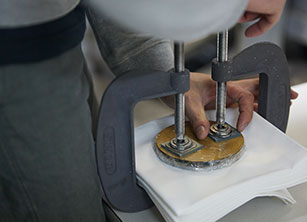 |
Brush Workshop (Imado, Taito-ku)
The Asakusa area is home to many wholesalers of shoes and leather goods. From the Edo period to the beginning of the Meiji period, a time when Western fashion began to arrive in Japan, a tannery stood on one side of the Sumida River and on the opposite bank, there were a large number of cobbler training workshops and small shoe factories. As times changed, factories that manufactured brushes for kimono fabric painting or house painting brushes came to also manufacture shoe and garment brushes. Today, the brush business is focused on making larger brushes for shoe factories, as well as shoe and garment brushes for retail shoppers.
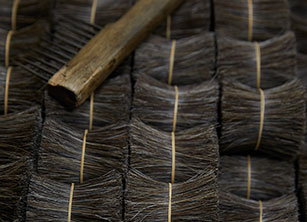 |
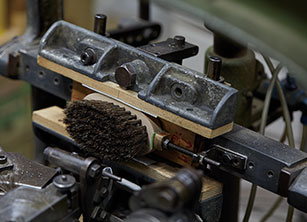 |
Leather Workshop (Higashi-Sumida, Sumida-ku)
Approximately 90% of pig leather production in Japan occurs in and around Sumida-ku. Most tanneries are located along riverbanks and in Tokyo, and are concentrated along the Arakawa River. In the parts of the Kanto region nearest to Tokyo, pig farming is common in many areas. These farms send pig skins to raw material wholesalers, where the skin, oil and fat are separated. The oils and fats are used to make soap, while the skins are tanned for making shoes and bags. The tanning process uses a great deal of water, and wastewater can be problematic. For this reason, new tanning techniques that utilise environmentally-friendly vegetable tannins have been developed here and are now being taught to the next generation of tanners not only in Japan, but around the world.
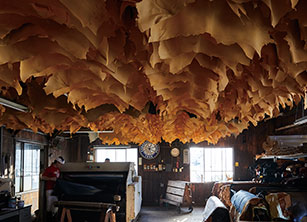 |
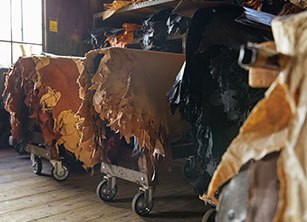 |
Forestry in Tokyo (Hinohara-mura, Nishitama-gun)
Approximately 40% of the total area of Tokyo is forest land. Forestry has long been a prosperous industry in the western part of the Tama region, with rafts carrying timber down the Tama River to lumber wholesalers in Fukagawa and Kiba since as far back as the Edo period. Demand for wood was high in Edo (today’s Tokyo area) due to fires that frequently occurred in the city, and the trees of the Tama forest were felled to meet this demand. Although the government later began planting cedar and cypress for building materials, the number of people working in forestry subsequently declined due in part to wood imports from overseas. Although shipping volumes have increased gradually over the past ten years, it is hoped that the Tama forest will continue to be protected as people living in Tokyo are using more local lumber from the Tokyo area.
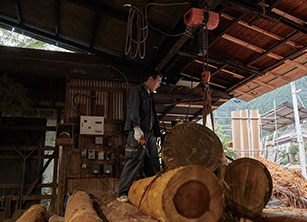 |
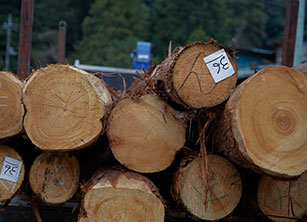 |
All item information and selling prices are subject to in-store display. Available while stock lasts.
Found MUJI items are available at MUJI Plaza Singapura only.